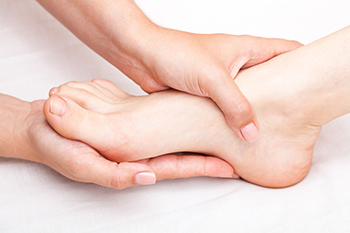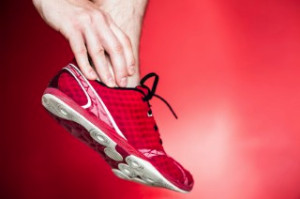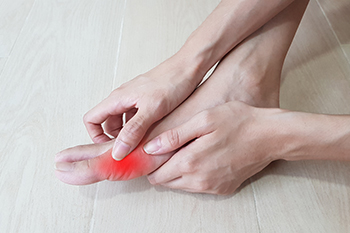April 2025
Choosing the Right Shoes for Marathon Running

Selecting the proper shoes for marathon running is essential to ensure comfort, performance, and injury prevention. The ideal running shoe should match your foot type, gait, and running style. It is important to choose a shoe that offers adequate cushioning to absorb impact while providing support and stability over long distance. Trying on shoes later in the day, when feet are slightly swollen, can give a more accurate fit. A snug but not tight fit is key, with enough room in the toe box to accommodate foot movement. Prioritizing comfort and function over style will help you stay focused on your training. If you are considering running in a marathon, it is suggested you confer with a podiatrist who can help you choose shoes that are right for you.
You should always make sure your running shoes fit properly in order to avoid injury. For more information, contact one of our podiatrists from Piedmont Podiatry Associates. Our doctors can provide the care you need to keep you pain-free and on your feet.
Choosing the Right Running Shoe for Your Foot Type
Improper shoe sizing can cause a myriad of problems for your feet. Shoes that don’t fit you properly can lead to muscular imbalances in your body, which can result in foot, knee, and hip injuries.
Tips for Finding the Right Running Shoe
- Make sure you have a thumb’s width of wiggle room between the end of your longest toe and the front of the shoe.
- There should be little to no slipping at the heel
- Don’t assume your size in one shoe brand will be your size in another
- Do not lace up your shoes too tightly
- Walk around in the store with your new shoes before you buy them
If you have any questions please feel free to contact our one of our offices located in Greenville, and Easley, SC . We offer the newest diagnostic and treatment technologies for all your foot and ankle needs.
Signs Your Feet May Reveal a Thyroid Problem

The feet can offer important clues about thyroid health, often showing symptoms that are easy to overlook. Cracked heels may be one of the earliest signs, especially when dryness persists despite moisturizing. Itchy feet can also occur due to slowed skin cell turnover, commonly seen with low thyroid function. Cold feet are another frequent symptom, as the thyroid helps regulate body temperature and poor circulation may result from an underactive thyroid. Additionally, swollen feet can develop due to fluid retention, which sometimes accompanies hormonal imbalances linked to thyroid conditions. These foot-related signs should not be ignored, especially when they appear together or persist. If you have any of the above foot symptoms, it is suggested that you consult a podiatrist who can treat various foot conditions, and discuss the connection regarding possible thyroid disease.
When dealing with systemic disease of the feet, it is extremely important to check the affected areas routinely so that any additional problems are caught quickly. If you have any concerns about your feet and ankles contact one of our podiatrists from Piedmont Podiatry Associates. Our doctors will assist you with all of your podiatric needs.
Systemic Diseases of the Feet
Systemic diseases affect the whole body, and symptoms usually are displayed in the feet. This condition can make a patient’s ability to walk unbearable. Systemic diseases include gout, diabetes mellitus, neurological disorders, and arthritis.
Gout – is caused by an excess of uric acid in the body. Common symptoms include pain, inflammation, and redness at the metatarsal/phalangeal joint of the base big toe. Gout can be treated by NSAIDs to relieve pain and inflammation, and other drugs that lower the acid levels in the body.
Diabetes mellitus – is an increase in the level of blood sugar that the body cannot counteract with its own insulin. Failure to produce enough insulin is a factor in Diabetes.
Diabetes of the Feet
Diabetic Neuropathy – may lead to damaged nerves and affect the feet through numbness and loss of sensation.
Peripheral Vascular Disease – can restrict the blood flow to the feet, and often times lead to amputation of the feet.
If you have any questions please feel free to contact one of our offices located in Greenville, and Easley, SC . We offer the newest diagnostic and treatment technologies for all your foot and ankle needs.
How to Prevent Ankle Sprains in Runners

Ankle sprains occur when the ligaments that support the ankle stretch beyond their limits or tear, often resulting from a sudden twist or roll of the foot. Common causes include uneven surfaces, improper footwear, lack of warm-up before activity, and previous ankle injuries that weaken stability. Athletes and individuals with poor balance or weak ankle muscles are especially at risk. To help prevent ankle sprains, it is important to maintain strength and flexibility in the lower legs and ankles. Wearing supportive shoes and practicing good technique during physical activity also play a key role. Avoiding sudden changes in movement and being mindful on unstable surfaces can reduce the chance of injury. If you have sustained a foot or ankle injury while running, it is suggested that you consult a podiatrist who can treat foot problems and help you with additional running injury prevention methods.
Exercising your feet regularly with the proper foot wear is a great way to prevent injuries. If you have any concerns about your feet, contact one of our podiatrists of Piedmont Podiatry Associates. Our doctors will treat your foot and ankle needs.
How to Prevent Running Injuries
Many common running injuries are caused by overuse and overtraining. When the back of the kneecap starts wearing out and starts causing pain in your knee, this is commonly referred to as runner’s knee. Runner’s knee is a decrease in strength in your quadriceps and can occur if you’re not wearing properly fitted or supporting shoes. To prevent runner’s knee, focusing on hip strengthening is a good idea, as well as strengthening your quads to keep the kneecaps aligned.
What Are Some Causes of Running Injuries?
- One cause of a common running injury is called iliotibial band syndrome.
- Plantar fasciitis is also another common injury.
- Stress fractures can occur from overtraining, lack of calcium, or even your running style.
Best Ways to Prevent Running Injuries
- Wear footwear that fits properly and suits your running needs.
- Running shoes are the only protective gear that runners have to safeguard them from injury.
- Make a training schedule. Adding strengthening exercises as well as regular stretching can help keep you strong and limber and can lessen the possibility of injuries.
- Stretching keeps muscles limber; this will help you gain better flexibility.
If you have any questions please feel free to contact one of our offices located in Greenville, and Easley, SC . We offer the newest diagnostic and treatment technologies for all your foot and ankle needs.
Symptoms and Causes of Gout

Gout is a form of arthritis that often affects the feet. The joint of the big toe is the most common site, but the ankles and midfoot can also be affected. Gout develops when uric acid builds up in the blood and forms sharp crystals in the joints, leading to sudden, intense pain, swelling, and redness. These gout symptoms often come on quickly, frequently at night, and may reach peak severity within a day. Gout attacks, termed flare-ups, usually resolve within a week, but without treatment, the condition often returns and can affect multiple joints over time. Risk factors for gout include being overweight, having high blood pressure or diabetes, and consuming foods and drinks high in purines, such as red meat and beer. Repeated attacks may lead to hard crystal deposits called tophi, which can permanently damage bone and joint tissue. A podiatrist can help confirm a diagnosis of gout and provide treatment to manage its symptoms and prevent further joint damage. If you have symptoms of gout, it is suggested that you schedule an appointment with a podiatrist for an exam and effective treatment solutions.
Gout is a painful condition that can be treated. If you are seeking treatment, contact one of our podiatrists from Piedmont Podiatry Associates. Our doctors will treat your foot and ankle needs.
What Is Gout?
Gout is a form of arthritis that is characterized by sudden, severe attacks of pain, redness, and tenderness in the joints. The condition usually affects the joint at the base of the big toe. A gout attack can occur at any random time, such as the middle of the night while you are asleep.
Symptoms
- Intense Joint Pain - Usually around the large joint of your big toe, and it most severe within the first four to twelve hours
- Lingering Discomfort - Joint discomfort may last from a few days to a few weeks
- Inflammation and Redness -Affected joints may become swollen, tender, warm and red
- Limited Range of Motion - May experience a decrease in joint mobility
Risk Factors
- Genetics - If family members have gout, you’re more likely to have it
- Medications - Diuretic medications can raise uric acid levels
- Gender/Age - Gout is more common in men until the age of 60. It is believed that estrogen protects women until that point
- Diet - Eating red meat and shellfish increases your risk
- Alcohol - Having more than two alcoholic drinks per day increases your risk
- Obesity - Obese people are at a higher risk for gout
Prior to visiting your podiatrist to receive treatment for gout, there are a few things you should do beforehand. If you have gout you should write down your symptoms--including when they started and how often you experience them, important medical information you may have, and any questions you may have. Writing down these three things will help your podiatrist in assessing your specific situation so that he or she may provide the best route of treatment for you.
If you have any questions, please feel free to contact one of our offices located in Greenville, and Easley, SC . We offer the newest diagnostic and treatment technologies for all your foot care needs.
Wounds That Don't Heal Need to Be Checked
Early Symptoms of Bunions

Bunions are a foot deformity that may begin with subtle signs and gradually progress to more noticeable discomfort. Early symptoms of bunions include swelling around the joint at the base of the big toe, along with redness that signals inflammation. Many people experience numbness and a burning sensation in the affected area. Over time, the foot shape may change as the big toe shifts toward the other toes, altering normal alignment. The altered pressure distribution often leads to the formation of calluses and corns on the inner side of the foot. Pain and discomfort during walking or prolonged standing may indicate that the condition is worsening. If you have any of the above symptoms, it is suggested that you visit a podiatrist who can offer you relief and treatment options.
If you are suffering from bunions, contact one of our podiatrists of Piedmont Podiatry Associates. Our doctors can provide the care you need to keep you pain-free and on your feet.
What Is a Bunion?
A bunion is formed of swollen tissue or an enlargement of boney growth, usually located at the base joint of the toe that connects to the foot. The swelling occurs due to the bones in the big toe shifting inward, which impacts the other toes of the foot. This causes the area around the base of the big toe to become inflamed and painful.
Why Do Bunions Form?
Genetics – Susceptibility to bunions are often hereditary
Stress on the feet – Poorly fitted and uncomfortable footwear that places stress on feet, such as heels, can worsen existing bunions
How Are Bunions Diagnosed?
Doctors often perform two tests – blood tests and x-rays – when trying to diagnose bunions, especially in the early stages of development. Blood tests help determine if the foot pain is being caused by something else, such as arthritis, while x-rays provide a clear picture of your bone structure to your doctor.
How Are Bunions Treated?
- Refrain from wearing heels or similar shoes that cause discomfort
- Select wider shoes that can provide more comfort and reduce pain
- Anti-inflammatory and pain management drugs
- Orthotics or foot inserts
- Surgery
If you have any questions, please feel free to contact one of our offices located in Greenville, and Easley, SC . We offer the newest diagnostic and treatment technologies for all your foot care needs.





